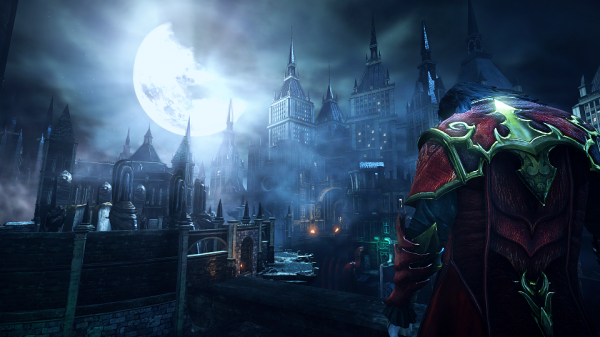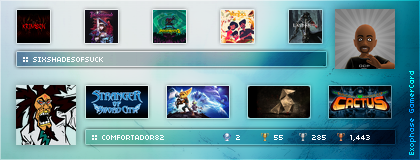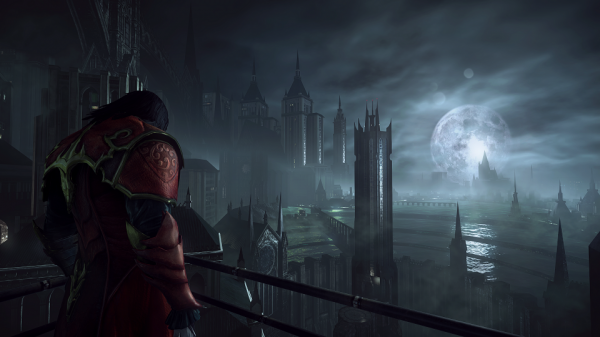
When I walk into the cramped, monitor-cluttered room Konami’s got set up, producer Dave Cox is standing off to one side, while Dracula, with Robert Carlyle’s voice, fights a bouncy, cackling, clown-headed boss who looks like Palpatine ate half of Jabba The Hutt.
No, Edgar, this is not something you see every day.
This was the press day for Castlevania: Lords of Shadow 2, set to hit on February 25th. The game was originally set to release back in October, but developer Mercury Steam took some extra time to spit shine the game, take advantage of the new engine, and really make it sing. Some of the advantages are obvious: There’s virtually no slowdown, no matter how busy the screen gets, which is something Lords of Shadow had a pretty serious problem with, and load times are much, much shorter than before (though this regrettably comes at the expense of the great Patrick Stewart narration between levels). Some speak for themselves, like the fact that somehow, even though it’s no shorter than the previous game, they managed to cram this game on a single disc on 360.
What keeps coming to mind, the more of these things you see and hear, is just how much the game feels like Mercury Steam doing a victory lap. Dave Cox would tell me later that Lords of Shadow is now the best selling game in the entire franchise, even counting the numerous times my beloved Symphony of the Night‘s been re-released. That’s a lot of pressure for a company who hit franchise paydirt seemingly out of nowhere, having only developed two disappointing games from American McGee and Clive Barker. The game appears to have met the challenge, though. These guys were the underdog taking the helm of Castlevania, and right around the time a newly vamped Gabriel Belmont took a swan dive out of a cathedral window, they were heroes.
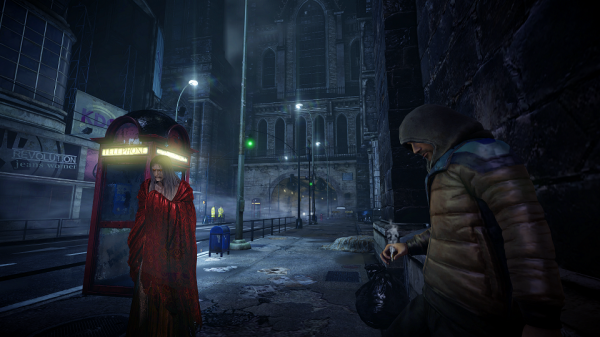 Lords of Shadow 2 more or less picks up right where that mind-blowing sonofabitch of an ending leaves off, too. The demo that I played at E3 (which is available to all if you buy Mirror of Fate HD, and you should) is essentially the game’s tutorial. Combat is, as mentioned, pretty much the same, except for the claws and the sword. The golden paladin is your boss fight, as expected, and that thing is no pushover. After it’s dead–death from a cross that, in the coolest and most insane way ever, EXPLODES FROM BLASPHEMY–we flash forward to present day, maybe days after Zobek offered the chance to go take down Satan himself. Gabriel wakes from his coffin, wraps himself in a cloak, and you’re left quiet, lonely, and trepidatious stepping out of the ruined cathedral into the modern city to wander. It’s around here that Oscar Araujo makes his presence known: A beautiful, sorrowful lilt of a track that made me fucking ache for this score like little else gaming scores have ever offered, punctuating that Gabriel’s exiled state at the end of Lords of Shadow as a sadder, more pathetic fate than advertised. Immortality has NOT been good to him.
Lords of Shadow 2 more or less picks up right where that mind-blowing sonofabitch of an ending leaves off, too. The demo that I played at E3 (which is available to all if you buy Mirror of Fate HD, and you should) is essentially the game’s tutorial. Combat is, as mentioned, pretty much the same, except for the claws and the sword. The golden paladin is your boss fight, as expected, and that thing is no pushover. After it’s dead–death from a cross that, in the coolest and most insane way ever, EXPLODES FROM BLASPHEMY–we flash forward to present day, maybe days after Zobek offered the chance to go take down Satan himself. Gabriel wakes from his coffin, wraps himself in a cloak, and you’re left quiet, lonely, and trepidatious stepping out of the ruined cathedral into the modern city to wander. It’s around here that Oscar Araujo makes his presence known: A beautiful, sorrowful lilt of a track that made me fucking ache for this score like little else gaming scores have ever offered, punctuating that Gabriel’s exiled state at the end of Lords of Shadow as a sadder, more pathetic fate than advertised. Immortality has NOT been good to him.
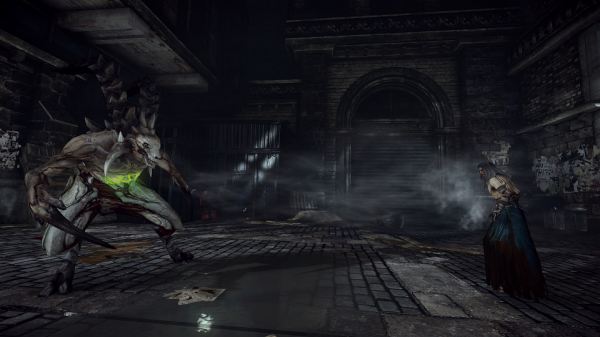 The sympathy doesn’t last long: Gabriel turns a corner, and is confronted by a goat-headed demon feasting messily on a corpse. The goat demon’s large and well-fed. Gabriel just woke up after a centuries-long nap, and his whole body looks like Iggy Pop’s penis. It’s no contest. You’re knocked unconscious, and you’re quietly whisked away.
The sympathy doesn’t last long: Gabriel turns a corner, and is confronted by a goat-headed demon feasting messily on a corpse. The goat demon’s large and well-fed. Gabriel just woke up after a centuries-long nap, and his whole body looks like Iggy Pop’s penis. It’s no contest. You’re knocked unconscious, and you’re quietly whisked away.
When Gabriel awakes, gasping and wounded, he’s laying on the floor of some unknown room, and someone was kind enough to bring breakfast: A cowering mother, father, and their child. We get the first inkling here that this is not going to be a warm and fuzzy hero’s journey. The game’s merciful enough to skip seeing Gabriel suck the kid dry, but has no qualms going first person, and frighteningly, ravenously, drinking the mother after brutally dispatching the father. It’s a pure, terrible, gothic, Nosferatu moment of horror of a kind we don’t get out of vampire lore these days, and goes miles towards establishing that playing as Dracula is going to be exactly that, with few, if any, punches pulled.
You finally get the basic rundown from Patrick Stewart’s Zobek, who’s managed to fit himself into the shoes of a modern CEO with ease. Satan’s acolytes have done the same, and the best way to give Old Scratch the business is to screw with his affairs on Earth. In exchange for helping to put Satan back in his place, Zobek will grant Gabriel a true death. So, having been fed, Zobek conjures up some old magic to get Gabriel his old outfit back, woven out of his flesh, which is a recurring theme, it looks like, seeing as his first projectile is daggers made of his own blood. Essentially, his red coat is a less grandiose version of Spawn’s cape.
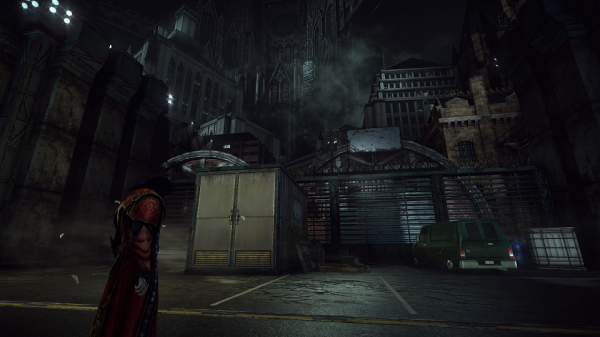 So, you’re dropped in on your first mission: infiltrating a pharmaceutical company manufacturing some nasty stuff to prepare for Satan’s coming. At first, it’s a little disappointing, going from cool, gothic architecture and classical tropes to musty warehouses and corridors, but there’s definitely tricks up this game’s sleeves. Your first major obstacles are giant cybernetic demon guards who kill on sight. There’s some minor stealthing around involved, but not of the same kind you’d imagine if the touch of Kojima was still felt on this thing. The first guard, you sneak past by using one of Drac’s new powers: slipping off into a corner, turning into a swarm of rats, sneaking out through the air vents. The second encounter involves sending a group of bats off to distract and damage a guard while you slide off behind his buddy. It’s simple, but fun. The third encounter involves sending the rats to eat through a set of wires powering a security system, waiting for a technician to get there, and then employing your third power: Possessing the living. At least so far it’s pretty much just so you can puppeteer guys into hitting switches, and getting past demons unseen, but it definitely lends the feel of being Dracula in a way I haven’t felt since the days of Legacy of Kain, and there’s a perverse appeal in being done with a victim, and basically making him implode in gore.
So, you’re dropped in on your first mission: infiltrating a pharmaceutical company manufacturing some nasty stuff to prepare for Satan’s coming. At first, it’s a little disappointing, going from cool, gothic architecture and classical tropes to musty warehouses and corridors, but there’s definitely tricks up this game’s sleeves. Your first major obstacles are giant cybernetic demon guards who kill on sight. There’s some minor stealthing around involved, but not of the same kind you’d imagine if the touch of Kojima was still felt on this thing. The first guard, you sneak past by using one of Drac’s new powers: slipping off into a corner, turning into a swarm of rats, sneaking out through the air vents. The second encounter involves sending a group of bats off to distract and damage a guard while you slide off behind his buddy. It’s simple, but fun. The third encounter involves sending the rats to eat through a set of wires powering a security system, waiting for a technician to get there, and then employing your third power: Possessing the living. At least so far it’s pretty much just so you can puppeteer guys into hitting switches, and getting past demons unseen, but it definitely lends the feel of being Dracula in a way I haven’t felt since the days of Legacy of Kain, and there’s a perverse appeal in being done with a victim, and basically making him implode in gore.
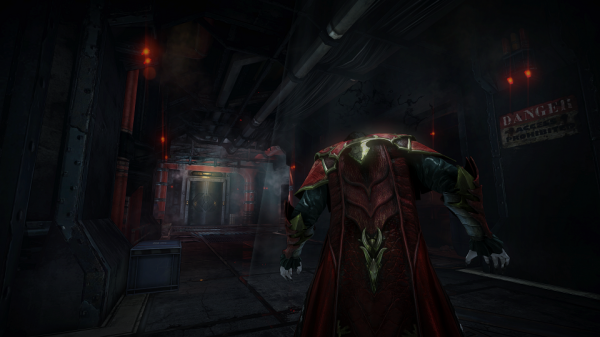 Our time at the factory also takes a detour halfway through, when Gabriel is in need of one of his old powers to continue. How he gets it back is a short jaunt being led astray by the ghost of his son Trevor, leading him through steadily shifting hallways that eventually turn entirely into the old castle. Right around here is where the game hints at greatness. The old Castlevania staple of hearts as power-ups has returned all too literally, as Gabriel steals a human heart from an altar and eats it to raise his energy up again. The empty castle beckons you forward by how loud you can hear the ghosts of victims Gabriel’s brought back to his castle–including his own family–scream for release. The ghost voices eventually lead to a beast being formed from the rubble, scythe-wielding knights, some hectic platforming when one of the wings of the castle starts to collapse, and obtaining an ice dagger allowing you to freeze water and enemies at will. The way you get back out is by following an evil wolf spirit guide through the void.
Our time at the factory also takes a detour halfway through, when Gabriel is in need of one of his old powers to continue. How he gets it back is a short jaunt being led astray by the ghost of his son Trevor, leading him through steadily shifting hallways that eventually turn entirely into the old castle. Right around here is where the game hints at greatness. The old Castlevania staple of hearts as power-ups has returned all too literally, as Gabriel steals a human heart from an altar and eats it to raise his energy up again. The empty castle beckons you forward by how loud you can hear the ghosts of victims Gabriel’s brought back to his castle–including his own family–scream for release. The ghost voices eventually lead to a beast being formed from the rubble, scythe-wielding knights, some hectic platforming when one of the wings of the castle starts to collapse, and obtaining an ice dagger allowing you to freeze water and enemies at will. The way you get back out is by following an evil wolf spirit guide through the void.
Eventually, you reach the end of the line at the factory. The place is being run by a witch. The stuff they manufacture turns ordinary humans into horrible, snarling demons. Not that any of this stops Gabriel from being able to grab any one of them at random and PUNCH A HOLE THROUGH THEIR HEART, but, you know, they’re trying. The boss fight with the witch is fairly predictable, but more disappointing due to how the game started than anything. Dave Cox promises the game doesn’t peak early. I’m almost certain he’s not kidding considering what we see after, a later stage in the game where the landscape opens up, and goes not-quite-open world. Random encounters, Zelda-ish minigames, hidden passages, all while traipsing around as much, much more inspired Gothic-Modern-Day level design. The first Lords of Shadow, even being a 20-hour+ game, feels almost quaint. I think it’s a safe bet anyone who liked the first one is going to have a very happy February.
